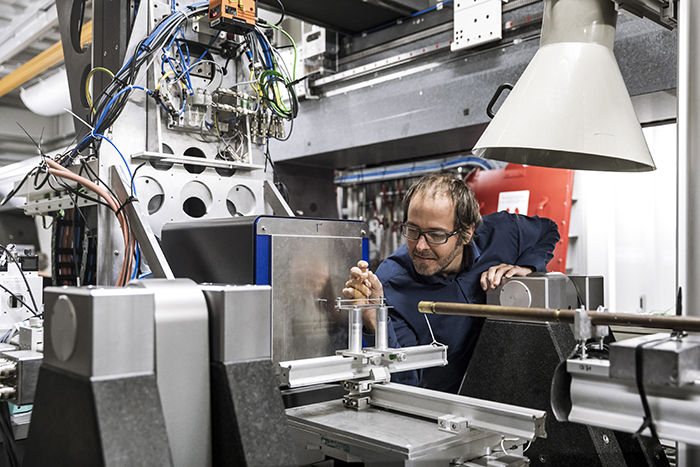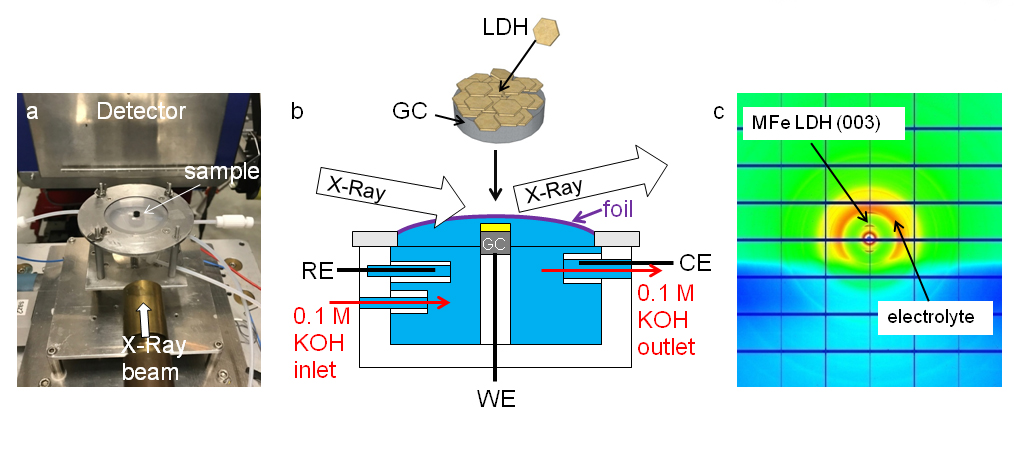- Home
- News
- General News
- Structure of key...
Structure of key catalyst for hydrogen generation unveiled
25-05-2020
A team led by the Technical University in Berlin has studied the layered metal-hydroxide catalysts for oxygen evolution reaction and their structure during actual catalysis at the ESRF. Such catalysts are key for hydrogen generation from water. The results are published in Nature Communications.
A key aspect of hydrogen economy is the process of water splitting to generate O2 and H2. This has been, among others, a major focus of electrochemical energy storage and conversion research in recent years.
However, fundamental and practical challenges remain. During this process, O2 generation at the anode through the oxygen evolution reaction (OER), is inherently slower by over four orders of magnitude compared with H2 generation, and accounts for the majority of energy losses.
NiFe based layered hydroxides are one of the the most active and relatively cheap OER catalysts suited for industrial water electrolysis. “Studying these kind of systems under in-situ conditions can provide a thorough understanding of the structure–property relationships of many related catalysts and potentially lead to design new catalysts with further improved performance”, explains Fabio Dionigi, scientist at the Technical University in Berlin and corresponding author of the publication.
 |
|
Jakub Drnec, scientist at ID31 and co-author of the paper, on the beamline. Credits: S. Candé. |
The team combined electrochemical measurements with operando wide-angle X-ray scattering (WAXS) at the ESRF using monochromatic hard X-rays , complemented with XAS data from Alba synchrotron, and theoretical calculations.
The team found that the catalysts actually undergo reversible structural transformation as they function. “These transitions are almost impossible to track without in-situ WAXS observations, so the contribution of the work on ID31 in this study is very important”, says Dionigi. The in-situ characterization allowed them to develop ab-initio model and understand why such catalysts are highly active.
 |
|
In situ grazing incident cell (GID) setup. a, Photography of the GID cell mounted at ID31 at ESRF. b, Drawings showing the GID cell and its components. WE, CE and RE stand for working, counter and reference electrodes. c, Example of 2D WAXS pattern showing that the stacking of the LDH nanoplatelets (b, top) gives rise to an arc for the (003) reflection (i.e. NiFe LDH in 0.1 M KOH). Credits: Dionigi, F. et al, Nature, 20 May 2020. |
Jakub Drnec, scientist on ID31 and co-author of the paper, explains that: “These results are an important step towards further development and incorporation of these new materials in the actual electrolyzer , the device making hydrogen in a sustainable manner from renewable sources”.
Reference:
Dionigi, F. et al, Nat Commun 11, 2522 (2020). https://doi.org/10.1038/s41467-020-16237-1.



